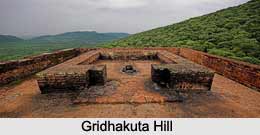 Gridhakuta Hill is a residual and sedimentary hill in Rajgir, Bihar. The altitude of the hill is 717.5 metres (2,354 ft). The hill is situated between the Kaimur Range to the north and the Maikal Hills to the south. Gridhakuta Hill is also known as the "Vulture"s Peak". The hill is famous for thousands of Hindu, Buddhist and Jain shrines built during the time of Mauryan Empire. This is the place where Lord Buddha preached many of his teachings and sermons. The place is also of archaeological importance. There are 4 caves on the hill in which rock paintings and mural paintings are visible.
Gridhakuta Hill is a residual and sedimentary hill in Rajgir, Bihar. The altitude of the hill is 717.5 metres (2,354 ft). The hill is situated between the Kaimur Range to the north and the Maikal Hills to the south. Gridhakuta Hill is also known as the "Vulture"s Peak". The hill is famous for thousands of Hindu, Buddhist and Jain shrines built during the time of Mauryan Empire. This is the place where Lord Buddha preached many of his teachings and sermons. The place is also of archaeological importance. There are 4 caves on the hill in which rock paintings and mural paintings are visible.
History of Gridhakuta Hill
Gridhakuta Hill is the place where Lord Buddha carried out many dialogues with his disciples during the rainy seasons after he achieved Enlightenment. It is the place where Lord Buddha started his second helm of commandment and preached many inspiring teachings and sermons to his disciples. He introduced King Bimbisara to Buddhism in this place. It was at Gridhakuta hill that Lord Buddha gave his two significant sutras the Lotus Sutra and the Prajnaparamita.
Gautama Buddha spent three months during the rainy season in retreat at the Gridhakuta hill, meditating and sermonising some of his most important discourses. The Buddha Sangha of Japan has raised a huge Shanti Stupa (Peace Pagoda), at the summit of the Gridhakuta hill in honour of Lord Buddha. This stupa is the central point of Rajgir, enclosing beautiful statues of Buddha outside and within.
Best Time to Visit Gridhakuta Hill
Gridhakuta Hill can be travelled throughout the year. However, the best time to visit the place is from October to March when the weather is pleasant and at its best. It is believed that one of the cousins of Lord Buddha had attempted to do suicide at this place.
This article is a stub. You can enrich by adding more information to it. Send your Write Up to content@indianetzone.com



















